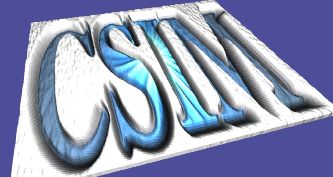 |
Example output.
Images To Terrains Convertor - Img2WFL_Terrain & Img2WFL_Map
These utilities convert arbitrary images to WFL (WinFrame Language) for viewing in the WinFrame-3D Viewer. They accept image files in the PNM (ex. .ppm) format, and produce the WFL XML format. The Img2WFL_Terrain and Img2WFL_Map utilities are very similar. But Img2WFL_Terrain produces a 3D grid of colored polygons, while Img2WFL_Map produces a 3D textured image. Img2WFL_Map is usually preferable, because it can produce higher quality and much more efficient renderings. It creates a conformant image texture instead of a polygon grid. Both utilities accept two image files on the command-line. The first provides elevation information, while the second supplies color image. Sometimes you can use the same file for both. Differences: - For Img2WFL_Terrain, the two images MUST MATCH IN SIZE, but can be any size in each dimension. - For Img2WFL_Map, the first file can be any size and dimension. The second file must be the same size in each dimension (square), and must be a multiple of 2. (ex. 64x64, 128x128, 512x512, etc..). It is preferable that the FIRST FILE BE LOWER-RES THAN THE SECOND FILE. By default, these utilities write their output to a file called "out.wfl". Please see the options below for other alternatives. Note: These utility convert dimensionless images to 3D objects. Therefore some assumptions must be made about the size-scale of the object, which in this case is usually considered a contoured terrain-plane. By default, the utility assumes units of meters. It scales the images to reside in the -5 km to 5 km range of the X and Z axes, and scales the elevation to range in the 0 to 500 meter range of Y axis. In other words, it maps the image to a 10x10 km area. If you wish alternative scale, please see options below.
 |
Download:
img2wfl_terrain.tgz (Right-click to save-as)
(Unpack with: tar xvfz img2wfl_terrain.tgz)
Contents:
Areadme.txt - This file.
img2wfl_terrain.c - Source file of img2wfl_terrain converter.
img2wfl_terrain.exe - Executable compiled for Linux (2.4)
img2wfl_map.c - Source file of img2wfl_map converter..
img2wfl_map.exe - Executable compiled for Linux (2.4)
Compile:
cc -O img2wfl_terrain.c -o img2wfl_terrain
cc -O img2wfl_map.c -o img2wfl_map
Usage:
img2wfl_terrain yourelevation_image.ppm your_colorized_map.ppm
img2wfl_map your_elevation_image.ppm your_colorized_mapimage.ppm
View output:
wf3d out.wfl
Options:
-v - Verbose
-o filename - Send output to specified file.
-suppresscamera - Normally a nominal camera setting is placed at the top
of the output file for direct viewing in WinFrame.
However, if you are producing a terrain object for inclusion
in an existing model which already has camera set-up, then
use this option to avoid inserting it.
-xrange xx - Set the X-range. Defaults to 10,000. Assumes meters.
By convention, consider X to be east-west axis in the X-Z plane.
-yrange xx - Set the Y-range, or span of elevations.
Defaults to 500. Assumed in meters.
-zrange xx - Set the Z-range. Defaults to 10,000. Assumes meters.
By convention, consider Z to be north-south axis in the X-Z plane.
Options Specific to Img2WFL_Map only:
- subdivide xx - Causes Img2WFL_Map to break the original texture image into sub-images
to reduce the size of the overall image. This may help with display
caching on some video cards. Sub-division rates of 2, 4, 8, and 16 are
supported. A total of xx-by-xx sub-images are generated and referenced.
See also: WF3d